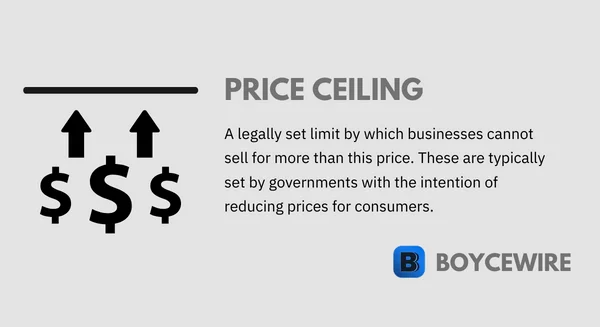Price Ceiling: Definition, Examples & Graph

What is a Price Ceiling
A price ceiling is a maximum price that a producer can charge for their good or service, often implemented by governments to ensure that essential goods and services are affordable for consumers. Examples include food, rent, and energy products, which may become too expensive for some consumers if left to the free market.
Price ceilings manipulate the equilibrium point between supply and demand, preventing the price of a good from increasing beyond a certain point. This can create a disincentive for producers to supply more of the good, as they may not be able to make a sufficient return on investment. For instance, in the case of rent control, landlords may be limited to a low rate of return, such as 2 percent, rather than the 10 percent they might otherwise earn. This can discourage new investors and construction firms from supplying new rental units to the market.
Key Points
- A price ceiling is a cap or limit on the amount producers and charge the customer for their goods or services.
- Price ceilings may potentially lead to excess demand in the market as it is left in disequilibrium.
- A price ceiling is usually put in place to protect consumers from high prices, particularly on necessities such as food, housing, or healthcare.
Effects of Price Ceiling
There aren’t many issues that economists tend to agree on, but price ceilings are one of them. According to the Center of the American Experiment, 81 percent of economists agree that price ceilings are bad economics. They lead to a number of negative effects which we will look at below.
1. Black Market
When a price ceiling is set below the market value, it creates excess demand, leaving consumers wanting goods but unable to purchase them. For example, a doughnut store selling fresh doughnuts for $0.10 each would be difficult to purchase because the price is significantly below the normal market price.
This causes a dramatic increase in demand and makes the supply scarce, resulting in doughnuts becoming difficult to come by. This pent-up demand can lead to black markets, where customers are willing to pay a price in excess of the price ceiling to obtain the goods they desire.
2. Crime
Price ceilings can lead to black markets, which are illegal. Additionally, they can also contribute to increased crime in other ways. Rent controls, for example, have resulted in housing deteriorating, which supports the ‘broken window’ theory, where such housing attracts crime.
Moreover, landlords are not earning as much money from their properties. Instead of earning a 5 percent return, they may earn less than 1 percent. This has, on occasion, led to arson as a way to recoup money from insurance.
3. Lack of Mobility
This effect is largely limited to rental price ceilings. To explain, price caps on rental units make it extraordinarily cheap – especially over time. What this does is lock people in who fear losing their cheap rent-capped accommodation. In New York, for example, many residents end up keeping rent-capped accommodation as a second home or refuse to move entirely – even if the accommodation is too large. Alternatively, it can result in overcrowding as families grow.
The logic behind this is that renting becomes a cheaper option than owning, thereby incentivizing residents to rent. At the same time, there is an incentive to work locally in order to stay at the same rent-capped accommodation – after all, it can be extremely difficult to obtain a rent-controlled apartment.
4. Poor Quality
When prices are unable to react to demand, a reduction in supply normally occurs. This can also lead to a decrease in the quality of the good or service. For instance, a price ceiling may prevent businesses from making a profit since the ceiling is below the cost of production. As a result, the company can choose to either go out of business or try to cut costs to make a profit at the lower price.
If we take it to the extreme and examine a car, for example, most new cars cost well above $15,000 in the US. However, what would occur if a price ceiling of $5,000 was imposed? Inevitably, a car that is worth that much would be produced, and it would most likely be made of cheap materials, unreliable, and of poor quality.
5. Shortages
Shortages happen because prices cannot respond to the demands of the market. A price ceiling is usually set below the point of equilibrium where supply and demand meet. This is done to make the goods or services affordable to the consumers. However, this is not beneficial for both parties. The demand for the goods is high, but the prices are not enough to motivate producers to supply them.
This is not necessarily because producers are greedy. It could mean that they would lose money by providing them. This issue is particularly problematic when the price ceiling has been in place for many years and is not rising in line with inflation. While the cost of producing the goods increases, the price the producers receive does not. Ultimately, this could cause many businesses to collapse as they cannot afford to keep producing.
6. Rationing and Queues
When prices are constricted by price ceilings, we see an excessive amount of demand. For example, the US imposed price restrictions on fuel in the 1970s following the OPEC crisis.
In this instance, prices were increasing as a result of a reduction in supply, which forced President Nixon to introduce a price cap. Demand remained the same, but because prices didn’t rise, producers kept output at lower levels. There was still a prolonged period of excess demand as supply was never able to increase.
As a result, there was a period of rationing whereby only cars with a certain number plate could get petrol on any one day. At the same time, queues were long and often people would wait hours to find there was no fuel left when they got there.
Price Ceiling Graph
Price ceilings are established to allow people who may not otherwise afford certain goods to purchase them. For instance, rent caps aim to ensure rent is affordable for low-income earners. Price ceilings on fuel and gas are also designed to reduce costs.
By lowering prices, more individuals can afford the products. A price ceiling would never be implemented above the equilibrium point, represented as P and Q*. This is because it would not make it affordable for consumers. The price ceiling is set BELOW the equilibrium point to reduce the producer surplus and make the goods affordable to consumers.
For example, a MacBook typically sells for around $1,000 in the US. Setting a price ceiling of $1,500 would be ineffective as it is already sold below that price. It’s like having a 10-meter-high ceiling in a home, which is unnecessary. To have an effect, the ceiling must be set below the existing equilibrium point.

When a price ceiling is put in place, it is set below the equilibrium point. As shown in the graph above, this can be seen at point Pc. At this point, both supply and demand are out of balance.
When the price is set at Pc, which is determined by the price ceiling, the quantity supplied is at Qs and the quantity demanded is at Qd. We can observe that there is a large gap between the amount supplied and the amount demanded. This difference is referred to as a shortage of supply.
In such situations, prices usually increase, which encourages producers to supply more to the market. However, as prices are capped, this does not happen, leading to an undersupply in the market.
Price Ceiling Examples
Governments often introduce price ceilings with the aim of protecting consumers and stopping inflation. Some general examples include:
- Rent controls This is a common example of a price ceiling. Rent control laws limit the amount of rent that landlords can charge tenants. This is usually done to prevent landlords from raising rents too high and making housing unaffordable for low-income tenants.
- Price controls on medicines Governments sometimes impose price ceilings on medicines to make them more affordable for consumers. This is often done in developing countries where people may not be able to afford life-saving medications.
- Maximum prices on consumer goods In times of crisis or during war, governments may impose maximum prices on certain consumer goods to prevent price gouging. This is done to ensure that essential goods remain affordable for consumers.
- Public transport fare caps Governments may impose fare caps on public transport systems to make them more affordable for commuters. This can be done by setting a maximum fare that transport providers can charge for a particular route.
Now let’s look at some real-life examples of price ceilings:
1. 1970s Oil Embargo
In 1973, the US and the world faced an oil crisis as the newly founded OPEC cartel worked together to stem the supply of oil and inflate prices. In part, this was in reaction to the perceived support of Israel during the Yom Kippur War.
The shortage of supply was met by a price ceiling, implemented by President Nixon in November of 1973. The price ceiling was based on prices as at March 1973 and allowed suppliers to increase prices, but only if profit margins were kept the same.
What resulted were long queues, strikes, and violent incidents due to the rationing of fuel. On top of that, the suppressed prices of oil prevented an acceleration in the development of US oil extraction. Had prices been allowed to increase, it would have provided US extractors an incentive to increase production and perhaps helped improve the efficiency of production at home.
2. New York City Rent Control
New York City has a long history of rent control which spans back as far as 1920. However, the cities regulation started to take off shortly after the Second World War. Since then, the details surrounding price ceilings has consistently changed. This has made it extremely complex as some buildings are regulated, whilst others are not – allowing people to take advantage of loopholes.
At the core of New Yorks price ceilings is the age by which the building was constructed. Depending on a number of other variables, this tends to include any buildings built before 1974 and some thereafter. Subsequently, the number of rental units has diminished over time, as old, rent-controlled apartments, make way for new builds.
As a result of these regulations, the number of rental units has declined as old apartments make way for newer buildings. It provides an incentive for the landlords to rebuild and gain exemption from the rent controls. These price controls have not only reduced the number of rental units available, but more importantly, the quality of rent-controlled units declined remarkably.
Rent control reduces investment in a property’s quality and causes a city’s housing stock to decay – which is exactly what happened in New York, especially throughout the 1980s.
3. Uber in India
First introduced in 2016, the Indian government implemented a price cap on Uber to prevent it from taking advantage of consumers in peak times. The issue was that during peak hours such as the weekend, after work, and at night. Known as price surging, this aggravated consumers and the government stepped in.
Customers are already experiencing poorer quality service – meaning longer waiting times as there is reduced supply. At the same time, drivers are receiving lower wages as a result of the cap – meaning many are leaving the job altogether as it doesn’t bring in the money they were expecting.
4. Consumer Goods in Venezuela
As a result of run away inflation, the government of Venezuela introduced a number of price ceilings on consumer goods with the aim of reducing inflation. However, this only led to shortages, with black markets developing in their place.
Related Topics
FAQs
A price ceiling is a government-imposed limit on the maximum price that can be charged for a good or service.
Rent control is one of the most common examples of a price ceiling. It prevents landlords charging tenants a higher price than the ceiling set by government. In doing so, tenants benefit from lower prices, but it equally diminishes the rental stock as landlords sell their property to owners in order to obtain a fair market value. At the same time, it becomes unprofitable to continue to maintain the property at lower rents – so rental units tend to fall into disrepair. In short – those on the outside cannot get a property, whilst those on the inside have to endure poorer quality residences.
Price ceilings are bad because they artificially create shortages. As part of supply and demand, when demand increases, prices increase to attract a higher level of production by suppliers. However, when prices are set artificially below the equilibrium point, prices are low, demand is high, and producers are unable to meet supply.
Generally speaking, price ceilings intend on making it cheaper for consumers to participate in the market. For instance, rent ceilings are implemented to ensure everyone has an affordable place to live and rent.
Yes, a price ceiling can benefit consumers by making goods and services more affordable. However, if the price ceiling leads to shortages or a decrease in quality, consumers may ultimately be worse off.
About Paul
Paul Boyce is an economics editor with over 10 years experience in the industry. Currently working as a consultant within the financial services sector, Paul is the CEO and chief editor of BoyceWire. He has written publications for FEE, the Mises Institute, and many others.

Further Reading
 Production Function: How to Calculate with Formula & Example - The production function calculates how many inputs you need to create X number of outputs.
Production Function: How to Calculate with Formula & Example - The production function calculates how many inputs you need to create X number of outputs.  Cost of Goods Sold - Cost of goods sold refers to the direct costs associated with producing or acquiring the goods that a company sells…
Cost of Goods Sold - Cost of goods sold refers to the direct costs associated with producing or acquiring the goods that a company sells…  Autarky Definition and Examples - Autarky is a self-sufficient economic state without international trade, but can limit growth due to higher costs, limited access to…
Autarky Definition and Examples - Autarky is a self-sufficient economic state without international trade, but can limit growth due to higher costs, limited access to… 